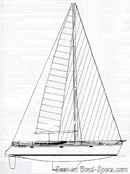Océanis 500 Wing keel
Sailboat specifications
The Océanis 500 is a 49’1” (14.98m) cruising sailboat designed by Philippe Briand (France). She was built between 1987 and 1991 by Bénéteau (France) with 158 hulls completed. The Wing keel version is offered with a short keel fitted with large winglets. This configuration provides an interesting draft / low center of gravity / upwind performance trade-off.
Océanis 500's main features
- Model
- Océanis 500
- Version
- Wing keel
- Hull type
- Monohull
- Category
- Offshore cruising sailboat
- Sailboat builder
- Sailboat designer
- Sailboat range
- Country
- France
- Construction
- GRP (glass reinforced polyester):
- Hull: Single skin fiberglass polyester
- Deck: Sandwich balsa fiberglass polyester - Number of hulls built
- 158
- First built hull
- 1987
- Last built hull
- 1991
- Appendages
- Keel : wing keel
- Helm
- Twin helm wheels
- Rudder
- Single spade rudder
- Unsinkable
- No
- Trailerable
- No
- Former French navigation category
- 1
- Standard public price ex. VAT (indicative only)
- N/A €
Océanis 500's main dimensions
- Overall length
- 50’ 2”15.3 m
- Hull length
- 49’ 1”14.98 m
- Waterline length
- 44’ 7”13.58 m
- Beam (width)
- 15’ 7”4.75 m
- Draft
- 5’ 11”1.8 m
- Light displacement (MLC)
- 30865 lb14000 kg
- Ballast weight
- 10803 lb4900 kg
- Ballast type
- Cast iron
Océanis 500's rig and sails
- Upwind sail area
- 1119 ft²104 m²
- Rigging type
- Sloop Marconi (in-mast furling mainsail) masthead
- Mast configuration
- Keel stepped mast
- Rotating spars
- No
- Number of levels of spreaders
- 2
- Spreaders angle
- Swept-back
- Spars construction
- Aluminum spars
- Standing rigging
- 1x19 strand wire
Océanis 500's performances
- Upwind sail area to displacementiThe ratio sail area to displacement is obtained by dividing the sail area by the boat's displaced volume to the power two-thirds.
The ratio sail area to displacement can be used to compare the relative sail plan of different sailboats no matter what their size.
Upwind: under 18 the ratio indicates a cruise oriented sailboat with limited performances especially in light wind, while over 25 it indicates a fast sailboat. - 193 ft²/T17.9 m²/T
- Displacement-length ratio (DLR)iThe Displacement Length Ratio (DLR) is a figure that points out the boat's weight compared to its waterline length. The DLR is obtained by dividing the boat's displacement in tons by the cube of one one-hundredth of the waterline length (in feet).
The DLR can be used to compare the relative mass of different sailboats no matter what their length:
a DLR less than 180 is indicative of a really light sailboat (race boat made for planning), while a DLR greater than 300 is indicative of a heavy cruising sailboat. - 158
- Ballast ratioiThe Ballast ratio is an indicator of stability; it is obtained by dividing the boat's displacement by the mass of the ballast. Since the stability depends also of the hull shapes and the position of the center of gravity, only the boats with similar ballast arrangements and hull shapes should be compared.
The higher the ballast ratio is, the greater is the stability. - 35 %
- Critical hull speediAs a ship moves in the water, it creates standing waves that oppose its movement. This effect increases dramatically the resistance when the boat reaches a speed-length ratio (speed-length ratio is the ratio between the speed in knots and the square root of the waterline length in feet) of about 1.2 (corresponding to a Froude Number of 0.35) . This very sharp rise in resistance, between speed-length ratio of 1.2 to 1.5, is insurmountable for heavy sailboats and so becomes an apparent barrier. This leads to the concept of "hull speed".
The hull speed is obtained by multiplying the square root of the waterline length (in feet) by 1.34. - 8.94 knots
Océanis 500's auxiliary engine
- Engine(s)
- 1 inboard engine
- Engine(s) power
- 80 HP
- Fuel type
- Diesel
- Fuel tank capacity
- 147.9 gal560 liters
Océanis 500's accommodations and layout
- Cockpit
- Closed aft cockpit
- Cabin(s) (min./max.)
- 3 / 5
- Berth(s) (min./max.)
- 6 / 12
- Head(s) (min./max.)
- 3 / 4
- Freshwater tank capacity
- 274.7 gal1040 liters
- Fridge/ice-box capacity
- 79.3 gal300 liters
- Boiler capacity
- 11.1 gal42 liters
- Maximum headroom
- 6’ 5”1.95 m



Bénéteau Océanis 500 sailplan - - 2/11
Picture extracted from the commercial documentation © Bénéteau
Picture extracted from the commercial documentation © Bénéteau








Bénéteau Océanis 500 interior and accommodations - - 9/11
Picture extracted from the commercial documentation © Bénéteau
Picture extracted from the commercial documentation © Bénéteau


Bénéteau Océanis 500 interior and accommodations - - 10/11
Picture extracted from the commercial documentation © Bénéteau
Picture extracted from the commercial documentation © Bénéteau


Bénéteau Océanis 500 interior and accommodations - - 11/11
Picture extracted from the commercial documentation © Bénéteau
Picture extracted from the commercial documentation © Bénéteau
Similar sailboats that may interest you:
Sailboats
First built hull
Hull length
1985
41’ 4”12.6 m
2010
49’ 1”14.98 m
2011
49’ 1”14.98 m
1988
52’ 6”16 m
2015
49’ 1”14.98 m
1987
48’ 1”14.65 m
1998
46’ 4”14.12 m
2000
52’ 6”16 m
2016
43’ 6”13.25 m
2017
50’ 11”15.51 m
1986
50’15.23 m
2004
44’ 4”13.51 m
2009
47’ 10”14.58 m
2011
47’ 10”14.58 m
2017
52’ 6”15.99 m